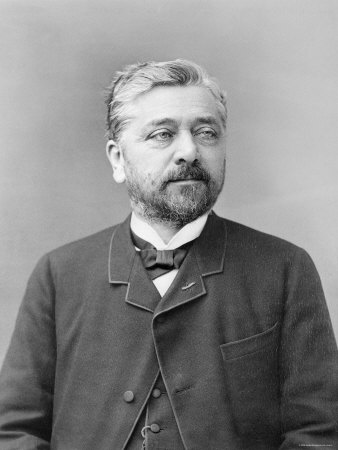Get Today in Masonic History into your Inbox. Sign up today for one of our email lists!
Need an article for your Trestleboard/Newsletter see our Use Policy
Alexandre Gustave Eiffel is Born

Today in Masonic History Alexandre Gustave Eiffel is born in 1832.
Alexandre Gustave Eiffel was French engineer.
Eiffel was born Alexandre Gustave Bönickhausen on December 15th, 1832 in Côte-d'Or, France. Eiffel's family name was Bönickhausen, although the family generally used Eiffel. It was not until 1880 that Eiffel officially changed his name from Bönickhausen. Eiffel attended classes at the Lycée Royal and was educated by various family members in a variety of sciences. He was accepted to two notable schools in Paris finally deciding to go with École Centrale des Arts et Manufactures where he graduated with a degree in chemistry.
When Eiffel graduated, family squabbles prevented him from going to work for his uncle as he planned. Eventually he went to work for Charles Nepveu. When Nepveu sold his company, he made sure to find a place for Eiffel at Compagnie Belge de Matériels de Chemin de Fer the company which acquired Nepveu's. Nepveu gave Eiffel his first major project the Bordeaux bridge.
In 1865, Eiffel departed Compagnie Belge de Matériels de Chemin de Fer as the economy had gotten bad and the company was nearing collapse. After leaving the company he became an independent consulting engineer. In 1866 he received a contract from the Egyptian government for Eiffel to oversee the construction of 33 locomotives. The job was high in profit and undemanding. Eiffel was able to travel to Egypt and visit the Suez Canal. Eiffel at the same time did work for the Exposition Universelle of 1867 by designing arch girders. He also conducted experiments to determine the modulous elasticity of cast iron.
In 1866, Eiffel borrowed enough money to start his company. Although he took on a partner at one point and it's name changed several times, it remained in existence until well after Eiffel's passing. Eiffel with the company made many innovations in metal construction. They built and designed the Maria Pia Bridge in Portugal which was the first of it's kind. Instead of pylons going into the river bed, the bridge was supported by a massive iron arch spanning 520ft.
In 1881, Eiffel was called in to assist in the building of the Statue of Liberty. He helped to create an inner framework which supported the outer copper. The statue was erected at Eiffel's ironworks in Paris before it was disassembled and shipped to the United States.
In 1886, Eiffel was given a contract for an Astronomical Observatory in Nice. In it's construction they were able to float the track on magnesium chloride in water. The dome was the largest at the time.
In 1884, preparations were underway for the 1889 Exposition Universelle. Eiffel had been approached with a design for what became known as the Eiffel Tower. Eiffel was unimpressed with the plans. It wasn't until another architect added to the existing design, Eiffel became interested in the plans. He bought out the patents for the design and made his bid to have the tower the center piece of the Exposition Universelle. There were several competitors for the distinction of being the centerpiece. A change was made to the requirements for the competition which made Eiffel's plan the only one fulfilling the requirements. Although most were impressed with the design, others felt the tower was going to detract from monuments already existing around Paris. The Eiffel Tower was only expected to last for 20 years and somewhat ironically has become a symbol of Paris. Later Eiffel, who formed a company to manage the tower put weather monitoring stations and used the tower for experiments involving air currents.
In 1888, Eiffel was contracted to work on a French Panama Canal. Unfortunately the company contracted with Eiffel discovered funds missing funds intended for the project. Despite the fact Eiffel was a contractor and was not involved in those dealings, he was accused as well. He was convicted initially and later acquitted on appeal.
Eiffel passed away December 27th, 1923.
Despite anecdotal indications to the contrary, there is no evidence Eiffel was ever a Freemason. Being a prominent well connected individual is generally why people want to put him as a member of the fraternity. It is also possibly because of his connection with the Statue of Liberty.

